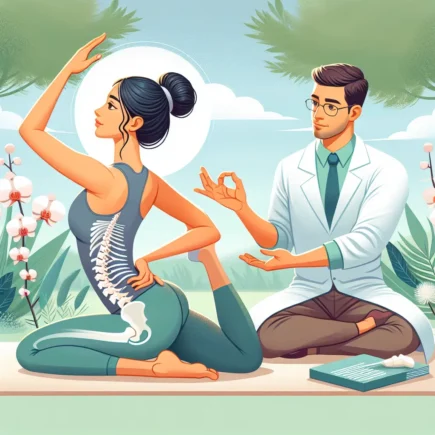The article “Understanding the Chemistry Behind Makeup Formulas” delves into the intricate details of the ingredients in makeup, shedding light on the effectiveness of concealers and the evolving science behind beauty products. It emphasizes the importance of understanding the chemical composition of makeup, empowering consumers to make informed choices and recognize potential allergens or irritants. Furthermore, the article highlights the significance of decoding cosmetic labels and reveals the truth about common cosmetic ingredients, urging readers to consider the safety and benefits of the products they use on their skin. Overall, it advocates for a more personalized and beneficial beauty experience through a deeper understanding of the chemistry behind makeup formulas.
Exploring the Efficacy of Virtual Reality Therapy for Anxiety Disorders
Anxiety disorders affect millions of people globally, causing excessive fear and worry, leading to distress and impairment in daily life. Current treatment methods include psychotherapy, medication, and lifestyle modifications, but many individuals do not achieve full remission or experience side effects. The article explores the growing interest in virtual reality (VR) therapy as a potential alternative or adjunct to traditional treatments for anxiety disorders. VR therapy aims to simulate real-life situations in a controlled, safe environment, providing exposure therapy tailored to individual fears and triggers. Research indicates significant reductions in anxiety symptoms and increased confidence post-therapy. As technology advances, VR therapy has the potential to revolutionize the treatment of anxiety disorders, offering a unique and valuable tool for mental health professionals. Recent studies demonstrate promising results regarding the effectiveness of VR therapy for anxiety, highlighting its potential as a novel and immersive approach to treatment.
Top 10 Makeup Trends for 2021
The article delves into the rising trend of bold and graphic eyeliner, showcasing its prevalence in both high-fashion and everyday makeup routines. It emphasizes the endless creative opportunities the trend offers, including sharp lines, geometric shapes, and vibrant colors. Additionally, the article advocates the use of bronzer powder to complement and enhance the striking eye look, and suggests Inglot Cosmetics’ bronzer powders for this purpose. Furthermore, it discusses the importance of using high-quality eyeliner products and provides tips on achieving precision and long-lasting wear. The piece concludes by emphasizing the trend’s potential for experimentation and self-expression, making it a must-try for makeup enthusiasts in 2021.
Effective Strategies for Providing Customer Support
The article discusses the importance of establishing clear communication channels with customers to provide effective customer support in today’s fast-paced digital world. It emphasizes the necessity of offering multiple communication options such as phone support, email, live chat, and social media to cater to diverse customer preferences. The significance of providing dedicated toll-free numbers for personalized phone support, setting clear expectations for email support, and training well-equipped agents for live chat support is highlighted. Additionally, the article explores the popularity of social media platforms as prominent channels for customer support and concludes by emphasizing the crucial role of diverse communication options in building trust, enhancing customer loyalty, and standing out in a competitive market. Moreover, it underlines the importance of implementing proactive customer support solutions to enhance the overall customer experience, discussing strategies such as leveraging customer data, providing self-service options, and utilizing technologies like chatbots and AI-powered systems.
Managing Spinal Discomfort: Tips for Relief and Prevention
Understanding spinal discomfort is crucial for relief and prevention, as it can stem from various causes like poor posture, muscle strain, injury, or underlying medical conditions, presenting symptoms like localized pain, stiffness, numbness, and mobility issues. The article highlights the importance of recognizing these causes and symptoms for effective management, emphasizing lifestyle changes as a key approach. Maintaining a healthy weight, engaging in regular physical activity, practicing good posture, incorporating stress-reducing activities, and consuming a nutritious diet are key lifestyle changes recommended for managing spinal discomfort. Furthermore, the article emphasizes the significance of integrating exercise and stretching routines into daily life, as these can strengthen muscles, improve flexibility, and reduce muscle tension, all contributing to spinal discomfort relief and prevention. By addressing these aspects comprehensively, individuals can proactively manage spinal discomfort, reduce the risk of future issues, and enhance their overall quality of life.
The Impact of Mindfulness on Overall Wellness
Understanding mindfulness and its effects on wellbeing is crucial in today’s stress-ridden world, where the practice of being fully present in the moment can significantly reduce stress levels, enhance mental clarity, and improve emotional regulation. Research has demonstrated that mindfulness has physical health benefits, such as lowering blood pressure, improving sleep quality, and strengthening immune function. The ability of mindfulness to promote self-awareness and self-compassion also contributes to greater overall wellbeing. Scientific studies have shown that mindfulness can lead to decreased activity in the amygdala, the brain’s center for processing emotions such as fear and anxiety, while simultaneously increasing activity in the prefrontal cortex, responsible for rational thinking and decision-making. Furthermore, mindfulness has been found to lower levels of cortisol, the primary stress hormone, in the body, and studies have revealed that mindfulness practices can alter gene expression related to inflammation, indicating its potential role in mitigating the physiological effects of stress on the body. Incorporating mindfulness practices into daily routines can have far-reaching positive consequences for individuals, making it a valuable tool in the pursuit of holistic wellness.
Challenges and Opportunities in Pain Management: A Critical Analysis
“Introduction to Pain Management: An Overview” provides a comprehensive insight into the critical aspects of pain management, highlighting the challenges and opportunities faced by healthcare professionals in delivering effective care. The article emphasizes the complex nature of pain and the need for a multidisciplinary approach, while also addressing the opioid epidemic and disparities in access to pain management resources. Moreover, it underscores the potential of innovative strategies, personalized medicine, and precision treatments in shaping the evolving landscape of pain management. Furthermore, the discussion of “Current Challenges in Pain Assessment” sheds light on the subjective nature of pain, communication barriers, and the lack of objective biomarkers, presenting significant hurdles in accurate pain assessment. The article advocates for a multi-faceted approach integrating patient-centered communication and advanced assessment tools to address these challenges. Lastly, “The Role of Opioids in Pain Management: Balancing Benefits and Risks” delves into the complexities of opioid use, emphasizing the need to balance their benefits with the associated risks. This compelling overview encourages readers to explore the full article, offering valuable insights into pain management and the importance of addressing these pertinent issues in healthcare.
Exploring the Effectiveness of Biomechanical Therapy for Musculoskeletal Disorders
Understanding the biomechanics of musculoskeletal disorders is essential for exploring the effectiveness of biomechanical therapy in addressing these conditions and improving patients’ quality of life. The article highlights the focus of biomechanical therapy on restoring proper function and movement patterns, emphasizing the significance of assessing posture, joint alignment, muscle imbalances, and movement patterns for developing tailored treatment plans. Research findings demonstrate the promising results of biomechanical therapy in reducing pain, enhancing function, and improving the overall quality of life for individuals with musculoskeletal disorders. The role of biomechanical therapy is pivotal in providing targeted, evidence-based interventions that address the root causes of dysfunction and promote long-term musculoskeletal health and injury prevention. Examining the efficacy of biomechanical interventions is crucial in advancing the understanding and management of musculoskeletal conditions, highlighting the potential of biomechanical therapy in comprehensive care.
The Most Effective Exercises for Building Core Strength
The article emphasizes the crucial role of core strength in overall fitness, highlighting its impact on daily activities, sports, posture, and injury prevention. It advocates for targeted exercises focusing on the core muscles, such as planks, Russian twists, and compound movements like squats and deadlifts. Stressing the benefits of a strong core for functional movement, back pain reduction, and spinal support, it urges readers to prioritize core strength in their fitness regimens. Additionally, the piece underlines the importance of a well-rounded core workout that engages all core muscles for enhanced strength and stability, ultimately promoting overall health and wellness.
The Role of Antioxidants in Preventing Chronic Diseases
The article provides a comprehensive understanding of antioxidants and their impact on health, emphasizing their role in combating chronic diseases. It discusses the significance of antioxidants in neutralizing free radicals, thus protecting cells and reducing the risk of conditions like heart disease and cancer. Emphasizing the importance of both dietary and internally produced antioxidants, it highlights the environmental factors that increase the body’s need for antioxidants. The article also explores the link between oxidative stress and chronic diseases, elucidating how antioxidants help mitigate oxidative damage and reduce the risk of conditions like diabetes and neurodegenerative disorders. It concludes by advocating for the incorporation of a variety of antioxidant-rich foods into one’s diet as a proactive approach to supporting overall health and disease prevention, while acknowledging the need for further research on antioxidant supplements.












